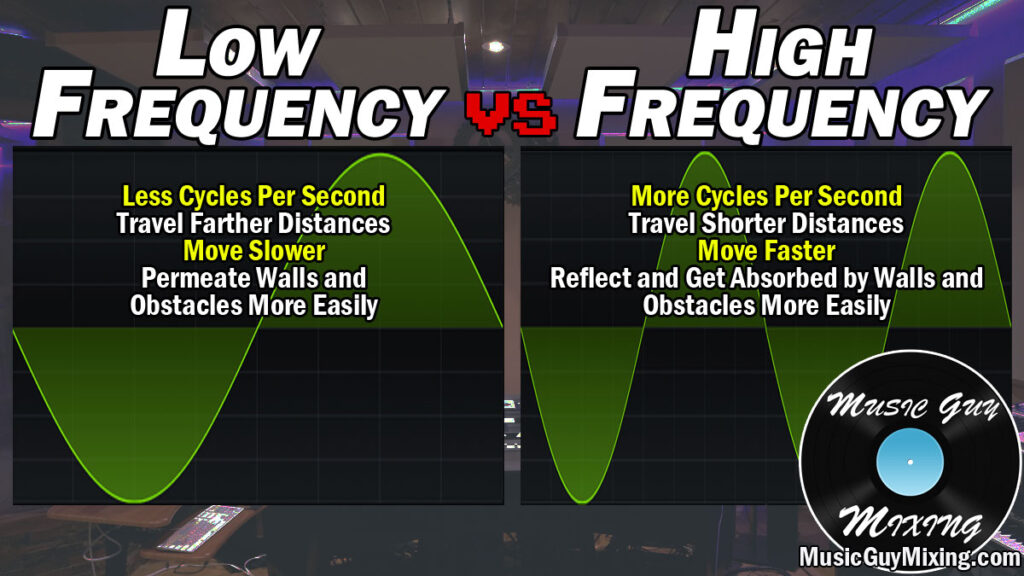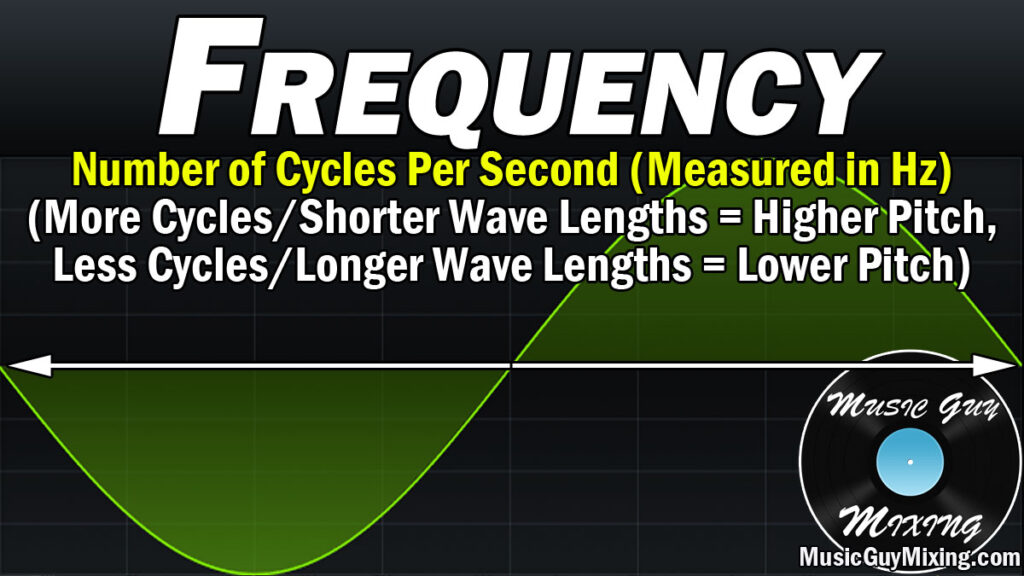Low frequency and high frequency rich sources differ in their makeup, speed, and even their behavior. Let’s cover the differences between low frequency vs high frequency sound waves.
Low Frequency Vs High Frequency

As we covered on our tutorial on the parts of a sound wave, the frequency of a waveform is determined by how many cycles its wave length makes each second:

The shorter a wave length, the more cycles it can make each second, resulting in a higher pitch.
Low Frequency Vs High Frequency Speed
To put it another way, more cycles a second means that higher frequency sound waves move much faster than low frequency sound waves.
The average human is capable of detecting between 20Hz and 20kHz. That’s sound waves traveling at 20 revolutions per second up to 20,000 revolutions.
Because higher frequency sound waves travel faster, the audible higher frequencies of a sound hit our ears before the rest of the sound (provided there’s enough amplitude or volume there).
This is known as the transient of the sound (see what are transients for more information).
Transients are important the context of our mix as, being the first thing we hear associated with a sound, they pull our attention to that sound.
For example, the transient on a snare occurs in that 5k region. When the stick hits the skin of the drum, that crack precedes the body, roundness, and subsequent ringing and decay of the snare.
If the transient of a sound isn’t pronounced enough, that track can sound dull or disappear in the mix. Oftentimes mixes which sound off are simply a result of a lack of adequate transients on one or more instruments, causing the mixer to make instruments louder than they should be, disrupting the balance of the entire mix.
Part of my recent tutorial on how to mix snare covered how to bring out more of that transient crack to bring our listener’s attention to the snare every time it hits. Once they detect that transient, they subconsciously pay more attention to the rest of that snare sound a split second later.
Low Frequency Vs High Frequency Distance
While high frequencies move faster, they also die off faster. The greater wave lengths of lower frequencies enables them to travel greater distances.
This is why you can usually only hear the bass and/or sub playing when a car drives by in the distance with music playing.
The same is true if you’re at a music festival and all you can hear from the band playing on the other side of the event is the kick, snare, and bass.
These instruments are all low and low-mid frequency rich, meaning they have the longest wave lengths and are capable of traveling the greatest distance. From your distance to the source, only the lowest frequencies can reach you.
The length alone isn’t the only determining factor at play here.
Low Vs High Frequency Reflections
Another characteristic relating to the difference in wave length between low frequencies and high frequencies is in how durable those sound waves are or how they react when they encounter an obstacle.
Higher frequencies/shorter waves are more likely to be absorbed or reflected off of sources.
Conversely, low frequencies have a greater ability to pass through or withstand surfaces. This also explains why you can hear a passing car’s bass and sub bass blasting out through the car, your wall, even the elements like wind outside when they drive by.
This is the same reason foghorns on ships utilize a low frequency rich sound to alert the surrounding area to its presence. The sound needs to able to cover a large distance to accomplish this in spite of the waves and heavy wind associated with open water.
Those lower frequencies are able to travel farther despite those obstacles of the wind and waves which would absorb higher frequencies at with ease.
The same principle is at work when you try increasing the size of the room on your reverb plugin and it yields a darker and low-mid frequency richer reflection.
The reverb is simulating a larger room. In a larger room, the higher frequencies die off before they can reach something to reflect back or before they can reflect and get back to you.
Only the lower frequencies can survive a larger room.
Conversely, the reflections you hear in a smaller room are generally brighter because the size of the room allows for those higher frequencies to reflect and return intact.
Low Frequency vs High Frequency Reviewed
- Low frequency vs high frequency sound waves have longer vs shorter wave lengths, respectively.
- Lower frequency sound waves move more slowly whereas high frequency sound waves move faster, hitting our ears before the lower fundamental body frequencies of a sound.
- Despite being slower, lower frequencies are capable of traveling farther than higher frequencies and permeating surfaces and obstacles.
- Conversely, higher frequencies are more likely to reflect or be absorbed by surfaces and obstacles.
- This is why lower frequencies are more prominent in larger rooms which higher frequencies don’t have the length to travel, and higher frequencies are more prominent in the reflections in smaller rooms.

Pingback: High Pass Filter and Low Pass Filter - The Difference Explained - Music Guy Mixing
Pingback: Delay Vs Reverb - What is the Difference/Which is Best - Music Guy Mixing
Pingback: Phone EQ - How to Get The Phone Sound Via EQ - Music Guy Mixing
Pingback: Complete EQ Settings Guide - Every Equalizer Setting Explained - Music Guy Mixing
Pingback: Noise Floor - What is the Noise Floor in Mixing - Music Guy Mixing